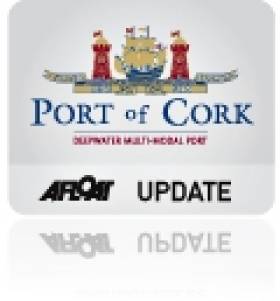Displaying items by tag: CorkCruise
Further Discovery as Cork-bound Cruiseship to Launch Season
#CruiseCORK – The first caller of the Cork cruise season is to be made this evening by Discovery, which as previously reported also started the 2013 season to Dublin Port last week, writes Jehan Ashmore.
She is to due to dock around 22.00hrs this evening alongside the deepwater berth at Cobh Cruise Terminal and where she will make an overnight visit.
A total of 60 cruise ships are scheduled to call in 2013, carrying in excess of 100,000 passengers and crew to be welcomed to the region.
Also recently reported on Afloat.ie was the announcement that the Port of Cork Company is to become 'a sister port' in an alliance with PortMiami, the "Cruise Capital of the World".
Close to 700 passengers can be accommodated on Discovery which is making her debut season operating cruises for Cruise & Maritime Voyages. On this cruise she embarked passengers from her homeport of Avonmouth, near Bristol in north Devon.
The UK based CMV are running cruises by the 20,000 tonnes vessel (and Marco Polo) this season. In tandem the owners of Discovery - Voyages of Discovery are marketing their own cruises using the same vessel under the 'Discovery Sailaway' banner.
Considerably larger cruiseships will call throughout the season to Cork Harbour, for further details and dates click this LINER-LIST.
For example the next caller on 27 April is Royal Caribbean Cruise Lines (RCCL) Vision of the Seas, of 78, 000 tonnes with a capacity for more than 2,400 passengers.
Cork Cruise Calls Set for Busiest Year
#CruiseLiners – A total of 64 cruiseships are scheduled to call to Cork Harbour, making the 2013 season the busiest year to date for the Port of Cork, writes Jehan Ashmore.
The increase in calls (from 57 in 2012), reflects further confidence of the cruise sector in 2013, where there will be 6 maiden calls to Cork and 2 will stay overnight.
A major coup for Cork is that for the first time, Europe's largest based cruise ship "Independence of the Seas" will welcome passengers to embark directly at Cobh on two cruises. Firstly in June and September, with 12-night cruises touring the Norwegian Fjords, organised by Lee Travel.
The giant vessel of 154,000 tonnes which is operated by RCCL, made her inaugural call to Cork in 2007 when she docked at the dedicated Cobh cruise terminal. From April 2013, the 4,375 passenger ship returns to running summer season cruises from her UK homeport of Southampton.
Cobh will look forward to many other callers throughout the season (cruise caller schedule) and where visitors will be given a very special welcome courtesy of CorkCruise. This is an initiative to provide tourist representatives to go on board each vessel. Following visits to Cobh, Cork City and beyond, a traditional Irish dancing and brass band performance are held on the quayside, as a fond farewell.
The efforts of CorkCruise, were recognised once again in 2011 when the Port of Cork was awarded two Cruise Insight Awards for 'Best Shore Side Welcome' and 'Best Tour Guides' which were announced at the global shipping conference, Seatrade Miami in April 2012.

























































